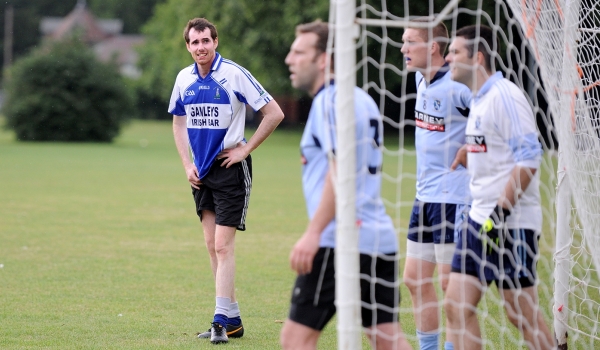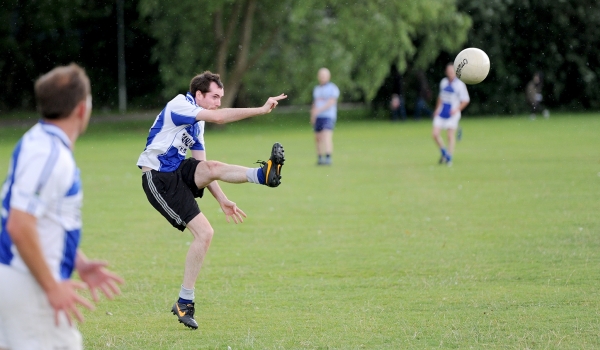6ft 5in second-generation Irishman James Martin had never touched an O’Neills ball in his life, so we dispatched him to his local GAA club. Here is his forthright and fascinating account of his first game of Gaelic football
Legs feel weak and heavy. Arms full of burning lactic acid. Chest feels tight and lungs ache. Eyes filled with hard, driving rain water. First touch — will it ever come? Here we go… Quick. Can I get there first? Get down. Aaah s***. Get back up. Go again. Whatever you do, don’t let that guy free. When the hell is the final whistle coming?
That’s a short, cleaned-up snippet of what was going through my mind at around 4pm on a wet Saturday out in a field in Reading.
It is the home of St Anthony’s GAA club and I was in the middle of my first Gaelic football game.
The Tuesday before, I had arrived at Mitcham Rugby Club in South London, training grounds of Round Towers GFC for my first session with the club.
It was my first session with any Gaelic club. I’d never even picked up a ball with ‘O’Neills’ written on it before. It was early evening and I had no idea what to expect.
I’d only seen a handful of games in my life. Most of them were of London during their heroic performances in this year’s Connacht Championship.
I introduce myself to Chris Lloyd, club chairman Kevin English and first-team manager Owen O’Neill. Even with memories of those brave exiles in the Championship, and the message from Ronan, sports editor at The Irish Post, ringing in my ears — “Go out and find your local GAA club. Try out the game. You’ll be fine” — I was still scared, as before the first warm-up drill, a vague dread swept through me.
Could you not have spent more time looking at the rules and techniques for the sport? What were you thinking letting yourself in for this? Will I hold up training by being completely useless?
Thoughts like these were not eased after the first drill. It was a simple exercise, the likes of which I’ve done in similar practices countless times in football (sorry, soccer). Four corners were marked by cones, each a short distance apart.
Under no pressure, you had to pass to the teammate to your right who’s running in an anti-clockwise direction towards the far corner. Then, follow your pass to the cone from where the guy who collected the pass was running.
My first attempted hand-pass, with fist clenched, sprays wildly over the head of the player waiting less than 10 yards away. Over-compensating, my next effort dies with a whimper, dropping short to the bemusement of my new teammate. Not a great start.
I hold my own in a mid-range kicking exercise, which increases my confidence slowly. However, any new-found belief is shattered soon after the coaches call a practice match. I’m ordered to mark a lively guy called JP, and I don’t do a very good job of it.
JP gets away from me three times in as many opening minutes. His pace leaves me chasing shadows as he racks up point after point. After the shaky start, I inch my way to get into the game.
I get my boot to the ball a couple of times, complete a few hand-passes and, somehow, even get a goal after a deft chip over the onrushing keeper.
Saturday won’t be too bad, will it?
 Feeling the pace: James take the chance to have a breather. Picture, Malcolm McNally
Feeling the pace: James take the chance to have a breather. Picture, Malcolm McNally
I have plenty of time during the week to consider my first appearance at the weekend.
Although Gaelic football is alien to me, both sides of my family have represented their counties, including my grandfather, William ‘Spider’ Kelly, who was an accomplished footballer for Wexford.
So there’s some ability in the blood. Born and raised in London, I’ve played soccer since I was five, as a centre-half who switched to goalkeeper in my teens.
I played rugby at school. I know I can catch, kick and am happy to throw myself around a bit.
How hard can it be?
It turns out, seriously hard. I’d been drafted into Round Towers’ squad as an emergency sub as a string of their players were on holiday.
Saturday came and I watched with envy as Reading football supporters passed through town to see their team’s first match of the season at the Madejski Stadium.
It’d be nice to sit in the stands and watch a game of soccer this afternoon.
That’s what I thought as, being one of only two subs, I knew I’d get a decent game. Anticipation started to mix with a tinge of anxiety. I watched the first half from the safety of the side-lines.
A right-hook thrown during an early scrap raises my level of anxiousness, as much as it does my sense of curiosity as the two players involved get up and carry on playing afterwards as if nothing had happened.
St Anthony’s dominate the first half. At the interval, we’re lucky to be only two points down as the home side prove wasteful in attack.
At the start of the second half, I get my chance as I’m thrown on at right corner forward.
Against the run of play, we score two goals in a frantic opening five minutes. I’d be lying if I said I’d had a hand in either of the scores (aside from a ‘decoy’ run up by St Anthony’s sideline) or in fact any real influence in the early part of the half.
I don’t get anywhere near the ball for about the first 10 minutes. The most action I get is after a look over at our photographer Malcolm, who nods towards the centre of the play as if to say: “You made me come out early in the rain for this? Get stuck in!”
Then a few minutes later I’m forced to do just that. My first touch is unsuccessful, as I try to pick up a loose ball rolling towards me in open play.
As I’d only recently learnt at training, a ball on the ground has to be scooped up by bending down and deftly using the foot and the hands in unison.
It isn’t as easy as it looks, and with my 6ft 5in frame, such a movement leaves me vulnerable to nearby opponents — like a spindly-legged deer being caught by a pair of lions in the African savannahs.
And sure enough, two predators in light blue shirts immediately appear as I bend down awkwardly — and lose the ball under my feet.
I get a smash on the forearm from one of the big lumps, something which I can still feel as I type this three days later.
After this opening ‘welcome to Gaelic’ hit, I gradually start to settle into the game. (I think) I patrol the right forward wing ably enough.
I’m called into action again as, soon after, I keep a difficult ball in at the far sideline and then thread a decent pass inside which sets my fellow forward teammate free for a shot at goal.
 The accidental shot-cross: one skill shared between Gaelic and soccer.
The accidental shot-cross: one skill shared between Gaelic and soccer.Picture: Malcolm McNally
I then get my hands on the ball in a bit of space and manage a cross-shot from out wide, which might just about look like a neat pass to my forward teammate.
Putting yourself about certainly seems to be a big part of football.
At times, as the lack of fitness showed among the players who’d been playing from the start, I found myself dropping deeper to get more involved.
We dug in to some spirited defending after a third goal, which came from nowhere, had taken us into a strong lead.
A cracking save from our goalkeeper Niall Dillon helped keep the distance between the two sides and the final score was a fairly flattering 3-7 to 1-6 win.
Toasting our victory in the Gateway pub in Reading — the local for St Anthony’s — and, stopping on the way home to watch Tyrone beat Monaghan and Dublin win against Cork in the All-Ireland quarters, there was time to reflect on some of the differences between playing soccer and Gaelic.
The first thing is the ball. It’s noticeably heavier. Gaelic is played fast and you’re constantly on the move. There seems to be more running and fewer stoppages.
My first 35 minutes felt closer to an hour and longer than any 45-minute half I’d played in soccer. Perhaps this was partly due to a lack of fitness on my part, but you get the sense that, because points are on offer from a distance out, any player can be within shooting range within seconds from anywhere around the half-way spot onwards.
This means you have to mark players hard and stick with them, whereas in soccer it’s possible to double up with a teammate, or mark zonally in many areas of the pitch where the action isn’t taking place or when there’s a longer break to set up a set piece.
Kicking, which I always thought I was pretty good at, is a totally different game when you are on the move with tired legs.
The presence of defensive players nearby throwing themselves at you makes it very hard to maintain your balance — and a cool head — when lining up a shot at goal.
It may sound obvious, but it isn’t something I’d considered when watching the top county players on TV.
The ‘fluid’ nature of some of the rules was also notable. A number of indiscretions seemed to be waved on by the officials. This ranged from people taking five or six steps with the ball in their hands (when the maximum is four) to consecutive bounces being waved on to punches which landed without much fuss from the officials.
To be fair, maybe some of these indiscretions would have been more strictly enforced if it was a competitive match; but I’m not entirely convinced.
What do I prefer about soccer? The game is more slick; less messy. You don’t have the insurance policy of being able to hoof it over the bar for a point should you not fancy going for goal.
Did I find myself out of my depth in my first game? Absolutely. But after my first taste of Gaelic I was definitely something of a convert to the sport.
Later on Saturday, after a few more post-match drinks with my new teammates, I got home with a slightly woozy head and sat down with a bag of chips (ever the athlete) to watch the first Football League highlights show of the year.
Having spent a full day watching — and competing in — fiery, passionate and bruising GAA games, there was something even more ludicrous than usual about watching the spoilt and overpaid soccer players tip-toeing around one another, falling down, claiming fouls after feather-like grazes from opponents.
While I’d be lying if I said my first experience of Gaelic had led me to turn my back on soccer just yet, as I dropped off, I felt happy to have joined a tough and competitive sport where the motivation for playing at any level is never in question.
The Round Towers club, which is very welcoming to new players, trains on Tuesdays and Thursdays. www.roundtowers.com/

